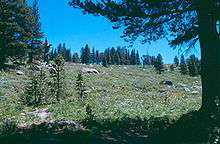Mokelumne Wilderness
| Mokelumne Wilderness | |
|---|---|
|
IUCN category Ib (wilderness area) | |
|
Round Top Peak in the Mokelumne Wilderness | |
 Map of the United States | |
| Location | Sierra Nevada Mountain Range, Alpine / Amador / Calaveras counties, California, United States |
| Nearest city | South Lake Tahoe, California (north), Markleeville, California (east) |
| Coordinates | 38°35′00″N 119°58′43″W / 38.58333°N 119.97861°WCoordinates: 38°35′00″N 119°58′43″W / 38.58333°N 119.97861°W |
| Area | 105,165 acres (425.59 km2) |
| Established | 1964 |
| Governing body | U.S. Forest Service |
The Mokelumne Wilderness is a 105,165-acre (425.59 km2)[1] federally designated wilderness area located 70 miles (110 km) east of Sacramento, California. It is within the boundaries of three national forests: Stanislaus, Eldorado and Toiyabe. First protected under the Wilderness Act of 1964, the Mokelumne’s borders were expanded under the California Wilderness Act of 1984 with the addition of 55,000[2] acres. The wilderness takes its name from the Mokelumne River, which was named after a Mi-wok Indian village located on the riverbank in California's Central Valley.[3]
The wilderness encompasses an area of the Sierra Nevada mountain range between Ebbetts Pass to Carson Pass. There are two sections separated by the Blue Lakes Road and an Off-Road Vehicle corridor.
Elevations range from 4,000 feet (1,200 m) to 10,381 feet (3,164 m). The highest point is Round Top (10,364 feet[4]), a remnant volcano from which the wilderness area's volcanic soils are derived from and is located on the east side of the Sierra crest.
Landscape, flora and fauna
The west slopes have been eroded by glaciation and water down to the granite bedrock which has created a dramatic contrast between the volcanic and the granitic landscapes.
The wilderness protects habitat for a great variety of plants and animals especially on the slopes of Round Top, which is designated a special interest area. Plants include Ponderosa pine, canyon live oak as well as alpine vegetation of Whitebark pine, subalpine fir, and western juniper, with western white pine, mountain hemlock, and lodgepole pine found in sheltered areas. Waterways such as the North Fork of the Mokelumne River have riparian zones of white and mountain alder, creek dogwood, western azalea and bitter cherry. Wildlife include the black bear and mule deer, as well as martin, bald eagle and the California spotted owl.[5]
Areas of special interest
The Round Top Botanical Area is at the junction of three botanical provinces and includes red fir forest, sagebrush scrub, subalpine and alpine environments. The combination of soil types, varying exposure and elevations produce diverse plant life, such as the phantom orchid (Cephalanthera austiniae), a rare plant that gets nutrients from dead material (saprophyte). The plant's common name is due to its color being all or mostly white.
The Round Top Geologic Area has more than 3,000 acres (12 km2) within the wilderness and encompasses a variety of geological areas, including exposed granodiorite, lava flows, dikes, glacial moraines and cirques. The landform known as Elephants Back is a rounded mass of solidified lava. Mineralization produced gold-bearing quartz veins, and relics of past gold mining activities are still present in the area.
Recreation

The Mokelumne Wilderness has a variety of recreational opportunities all year. With landscapes ranging from deep canyons to alpine heights and more than two hundred ice-scoured lakes and tarns, fishing and hiking are popular activities as well as cross country skiing. Access is from roads surrounding the wilderness boundary with Carson Pass being the most used entry point. The Pacific Crest Trail, the Tahoe-Yosemite Trail and the Emigrant Summit Trail all cross through the Mokelumne Wilderness. The Emigrant Summit Trail is a designated National Recreation and Historic Trail that follows the western boundary and then passes through the wilderness from Emigrant Valley to Caples Lake.
Wilderness permits are required year-round for overnight visits.[6]
Footnotes
- ↑ Official site -Stanislaus NF, Mokulumne History page
- ↑ California Wilderness Act of 1984, P.L. 98-425 Sec.101(16)
- ↑ Sierra Nevada Wild webpage on Mokelumne Wilderness accessed 16 October 2008
- ↑ United States Geological Survey Feature Detail Report.
- ↑ Adkinson p.153
- ↑ http://www.fs.fed.us/r5/eldorado/recreation/wild/moke/permit/
References
Eldorado National Forest Interpretive Association website. accessed July 30, 2009
Adkinson, Ron Wild Northern California. The Globe Pequot Press, 2001
External links
-
 Media related to Mokelumne Wilderness at Wikimedia Commons
Media related to Mokelumne Wilderness at Wikimedia Commons - Eldorado National Forest: Mokelumne Wilderness webpage
- Stanislaus National Forest: Mokelumne Wilderness webpage
- Wilderness.net: Mokelumne Wilderness webpage